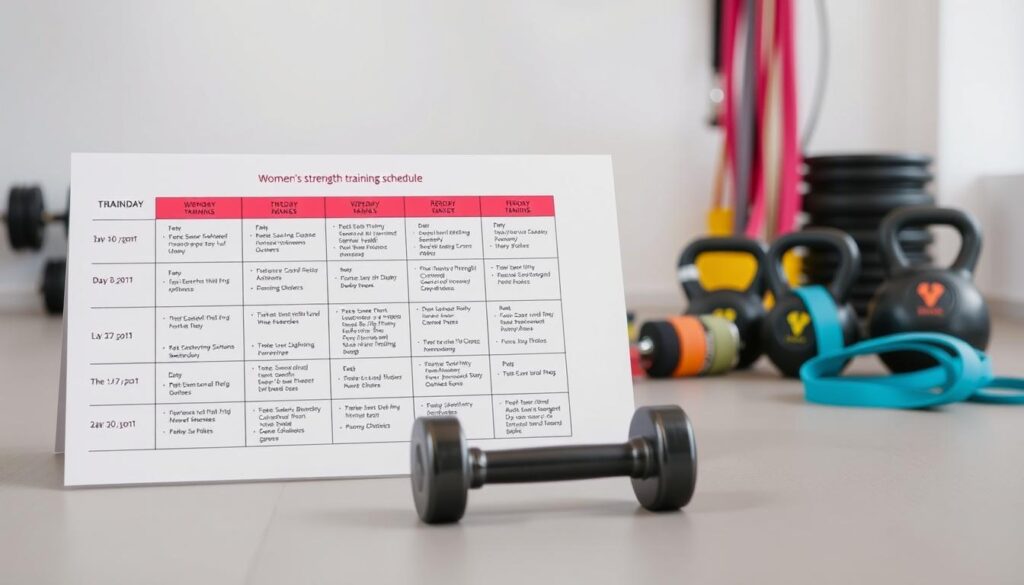Are you looking for a workout plan to help you achieve your fitness goals and change your body? A well-structured workout split can unlock your full potential. By dividing your workout into specific days and focusing on different muscle groups, you can maximize your gains and see real progress.
With a 4-day or 5-day workout split, you can make your routine fit your needs. Whether you’re aiming for fat loss, muscle gain, or overall strength improvement, this approach works. It lets you target specific areas, boost your energy, and stay on track with your fitness journey. Find out how the right workout split can help you reach new heights in your fitness goals.
What are Strength Training Splits?
For women looking to improve their strength training, knowing about splits is essential. A workout split organizes your week by focusing on different muscle groups or training styles each day.
Definition of Strength Training Splits
Strength training splits mean dividing your workouts into days, each targeting specific muscles. This method allows for deeper training and better muscle recovery.
Benefits of Using Splits for Training
Strength training splits bring many advantages, including:
- More muscle mass from focused training
- Improved strength overall
- Enhanced recovery with less muscle group repetition
- More workout variety to avoid plateaus
How Splits Differ from Full-Body Workouts
Unlike full-body workouts, which cover all major muscles in one session, splits spread the work over several days. This is key for women aiming to build muscle or boost endurance.
| Day | Muscle Group | Example Exercises |
|---|---|---|
| Monday | Chest & Triceps | Bench Press, Tricep Pushdowns |
| Tuesday | Back & Biceps | Pull-ups, Bicep Curls |
| Thursday | Legs | Squats, Lunges |
| Friday | Shoulders & Abs | Shoulder Press, Planks |
By using strength training splits, women can customize their workouts to achieve their fitness goals. Whether it’s to boost strength, tone muscles, or improve health, splits offer a tailored approach.
Choosing the Right Split for Your Goals
Strength Training Splits
First, understand your fitness goals. This will help you pick the best strength training split. Your goals guide you to the right split for your needs.
Strength training isn’t one-size-fits-all. Women have different goals, like building muscle or boosting endurance. A good strength training routine for women should match their goals.
Aligning Splits with Fitness Objectives
Strength Training Splits
To match your strength training split with your goals, know what you want to achieve. Do you want to grow muscle, get stronger, or perform better in sports? Your goals shape your training program.
“The key to successful training is not just the exercises you do, but how you tailor them to your specific goals.”
If you aim to build muscle, focus on a split that trains specific muscles often. For overall fitness, a balanced split that covers all major muscles is better.
Factors to Consider: Time, Experience, and Frequency
Choosing a strength training split involves several factors. Consider your training time, experience, and how often you can work out.
| Factor | Considerations |
|---|---|
| Time | How many days per week can you dedicate to training? |
| Experience | Are you a beginner, intermediate, or advanced lifter? |
| Frequency | How often can you train each major muscle group? |
A women’s strength training split program must consider these factors. For example, a busy schedule might mean a 4-day split. More time allows for a 5-day split.
The right split for you depends on your goals, time, experience, and how often you can train. By thinking about these, you can make a strength training routine that works for you.
Overview of 4-Day Strength Training Splits
If you’re into weightlifting, a 4-day split can really help. It lets you focus on different muscle groups each day. This might lead to more balanced strength gains.
A 4-day split is great for those with some weightlifting experience. It balances workout days with rest days. This balance is key for muscle recovery and growth.
Sample 4-Day Split Routine
A sample 4-day split routine could look like this:
- Day 1: Chest and Triceps
- Day 2: Back and Biceps
- Day 3: Legs
- Day 4: Shoulders and Abs
This routine covers all major muscle groups in four days. It allows for enough rest and recovery time.
| Day | Muscle Group | Example Exercises |
|---|---|---|
| 1 | Chest and Triceps | Bench Press, Tricep Pushdowns |
| 2 | Back and Biceps | Pull-ups, Bicep Curls |
| 3 | Legs | Squats, Lunges |
| 4 | Shoulders and Abs | Shoulder Press, Planks |
Best Practices for 4-Day Training
To get the most out of a 4-day split, follow these best practices:
- Make sure you eat enough protein for muscle recovery.
- Adjust weights and reps based on your fitness level and goals.
- Give enough rest between sessions for the same muscle group.
Consistency is key for seeing results. Stick to your schedule and adjust as needed.
“The last three or four reps is what makes the muscle grow.”
Modifications for Beginners
Strength Training Splits
If you’re new to strength training, start with a modified 4-day split. You might:
- Start with 3 or 2 days, based on your fitness level.
- Use lighter weights and higher reps to build endurance.
- Focus on proper form and technique to avoid injuries.
As you get more comfortable, you can increase the intensity and volume of your workouts.
Exploring 5-Day Strength Training Splits
Looking to boost your strength training? A 5-day split can be a great choice. It lets you focus on different muscle groups each day. This can lead to more balanced strength gains.
Sample 5-Day Split Routine
A typical 5-day split routine might look like this:
- Monday: Chest and Triceps
- Tuesday: Back and Biceps
- Wednesday: Legs
- Thursday: Shoulders and Abs
- Friday: Arms
This routine targets all major muscle groups. It’s great for women wanting to boost strength and muscle tone.
Advantages of a 5-Day Split
A 5-day split focuses on specific muscle groups. This is good if you want to improve certain areas. It also prevents plateaus by changing workout intensity and type.
Upton says working out more than 4 days a week won’t always lead to better results. But, if you’re doing a 5-day split, make sure you’re not overdoing it. Too much can cause injury or burnout.
Tips for Staying Motivated
Staying motivated with a 5-day split needs commitment and a good plan. Here are some tips:
- Set Clear Goals: Know what you want to achieve, like better strength, more muscle, or endurance.
- Vary Your Routine: Change exercises or their order to keep workouts interesting and challenging.
- Track Your Progress: A workout log shows how far you’ve come. It’s a great motivator.
By following these tips and sticking to a 5-day split, you can see big improvements in your fitness.
Essential Exercises for Women in Strength Training splits
Strength Training Splits
Women should do exercises that work many muscles at once. This makes workouts more efficient and helps balance strength.
Upper Body Exercises
Strong upper bodies are key for daily tasks and fitness. Good upper body exercises are:
- Bench Press: Works the chest, shoulders, and triceps.
- Pull-ups: Targets the back, shoulders, and arms.
- Dumbbell Rows: Strengthens the back and shoulders.
- Shoulder Press: Develops shoulder strength.
These exercises can be changed to fit different fitness levels. This makes them great for many women.
Lower Body Exercises
Strong legs and hips are important for moving and staying balanced. Key exercises are:
- Squats: Works the legs, glutes, and core.
- Deadlifts: Targets multiple muscle groups including legs, back, and glutes.
- Lunges: Strengthens the legs and glutes.
- Leg Press: Focuses on leg strength.
These exercises boost functional strength. They can be adjusted for different fitness levels.
Core Strengthening Moves
A strong core is key for stability and athletic performance. Good core exercises are:
- Plank: Strengthens the core muscles.
- Russian Twists: Targets the obliques.
- Leg Raises: Works the lower abs.
- Bicycle Crunches: Engages the entire core.
Adding these exercises to your routine boosts core strength and stability.
| Exercise | Muscle Groups | Benefits |
|---|---|---|
| Bench Press | Chest, Shoulders, Triceps | Upper body strength, muscle mass |
| Squats | Legs, Glutes, Core | Lower body strength, functional fitness |
| Plank | Core | Core strength, stability |
Addressing Common Concerns About Strength Training
Strength training can seem scary, especially for women who are new to it. Many worry about getting too big or hurting their joints. But, with the right info and help, you can beat these fears and reach your fitness goals.

Strength Training Splits
Myths About Women’s Strength Training
One big myth is that strength training makes women bulky. But, getting really big requires a special training and diet plan that most women don’t follow. Most won’t grow a lot of muscle without hard work and the right training.
Another myth is that strength training doesn’t help with weight loss. But, it can actually help you lose weight by building muscle. This muscle helps your body burn more calories, even when you’re not working out.
Safety and Injury Prevention Tips
To make sure strength training is safe and works, focus on doing it right. Begin with lighter weights and slowly add more as you get stronger. This way, you avoid injuries and make sure you’re working the right muscles.
- Warm up before each workout with 5-10 minutes of light cardio and dynamic stretching.
- Use a full range of motion when performing exercises to maximize effectiveness and minimize the risk of injury.
- Listen to your body and rest when needed. Overtraining can lead to injury and burnout.
By knowing the truth about strength training and following safety tips, you can confidently add it to your workout routine. You’ll enjoy all the good things it brings.
Nutrition for Optimal Strength Training Results
Good nutrition is key for a strong strength training program. It helps your muscles recover and grow. When you’re focusing on your strength training, make sure to eat the right foods to help you reach your goals.
Importance of Protein in Recovery
Protein is vital for muscle repair after working out. It helps fix and grow muscle fibers. To support muscle recovery and growth, aim for 1.2 to 1.6 grams of protein per kilogram of body weight daily.
Lean meats, fish, eggs, dairy, and plant-based foods like beans and tofu are great protein sources. If you can’t get enough protein from food, consider protein powder.
Timing Meals Around Workouts
Eating at the right time can boost your workout and recovery. Eat a balanced meal with protein and complex carbs 1-3 hours before your workout. This gives you energy and supports muscle function.
After working out, eat a mix of protein and carbs within 30-60 minutes. This can be a shake or a meal, based on what you prefer and need.
Hydration Strategies for Lifters
Drinking enough water is crucial for strength training and health. Aim for 8-10 glasses of water a day. Drink water before, during, and after your workouts.
To check if you’re hydrated, look at your urine. If it’s pale yellow or clear, you’re good. Also, weigh yourself before and after workouts to see how much water you’ve lost. Adjust your water intake based on this.
Designing Your Strength Training Schedule
Strength Training Splits
A well-structured strength training schedule is key to a successful fitness plan. To reach your fitness goals, planning your strength training is crucial.

Strength Training Splits
Weekly Planning Tips for Your Split
When setting up your strength training routine for women, think about your weekly schedule and goals. Pick specific days for strength training, making sure you have enough time for each workout. For a 4-day or 5-day split, choose days that give you enough rest and recovery time in between.
For instance, in a 4-day split, you might do strength training on Monday, Tuesday, Thursday, and Friday. Leave Wednesday, Saturday, and Sunday for rest or other activities. This balance helps with training and recovery.
Incorporating Rest and Recovery
Strength Training Splits
Rest and recovery are vital parts of any strength training schedule. Enough rest lets your muscles recover and get stronger. Make sure you get enough sleep and include rest days as needed.
- Listen to your body and adjust your schedule accordingly.
- Incorporate stretching and foam rolling to aid in recovery.
- Consider active recovery techniques like light cardio or yoga on rest days.
Tracking Progress Effectively
To stay motivated and adjust your strength training routine for women as needed, track your progress. Use a workout log to record your exercises, sets, reps, and weight lifted. Regularly reviewing your progress helps in making informed adjustments to your schedule.
Also, track other metrics like body weight, measurements, or progress photos. This gives a full view of your fitness journey.
Staying Committed to Your Strength Training Journey
Strength Training Splits
Starting a strength training program is exciting. But, staying committed is key to reaching your fitness goals. A good plan is just the start. Keeping up the effort over time needs dedication and the right mindset.
Realistic Goals for Long-Term Success
Setting achievable goals is vital for staying motivated. Break big goals into smaller, easier steps. This way, you can see your progress and feel less overwhelmed.
The Power of a Support System
A support system can really help you stick to your fitness goals. Surround yourself with people who get and support your goals. This could be a workout partner, a fitness group, or online forums for sharing tips and experiences.
Celebrating Progress
Don’t forget to celebrate your achievements. Acknowledge every small win to boost your commitment. By staying dedicated and focused, you’ll keep up a regular workout routine. And you’ll enjoy the perks of targeted strength training for females.


